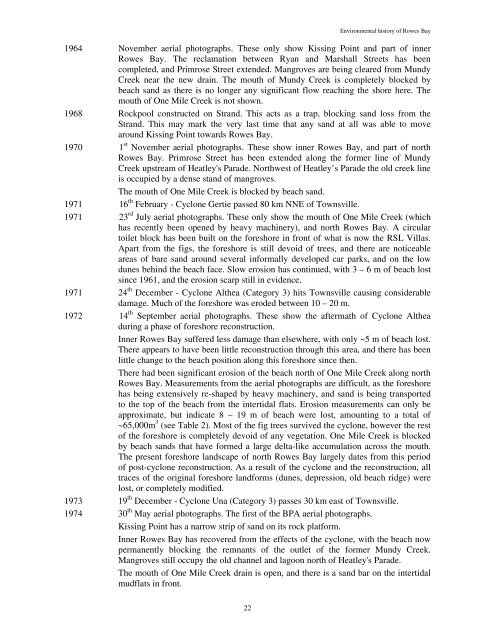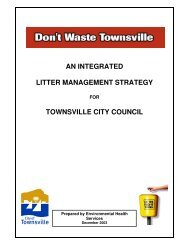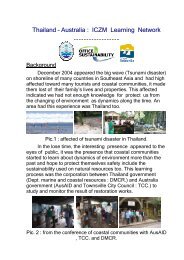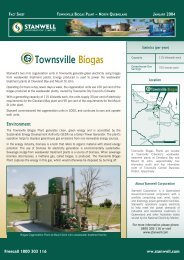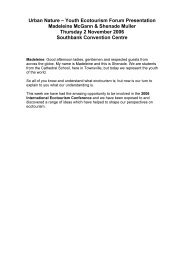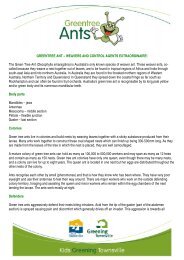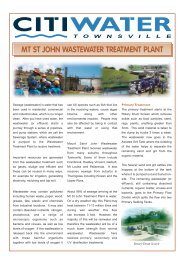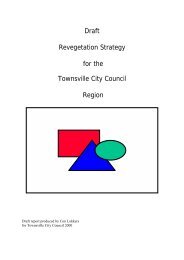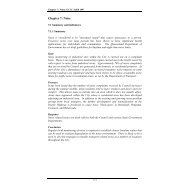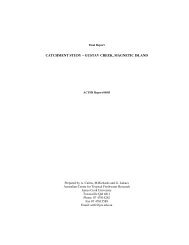ENVI RONMENTAL HI STORY OF ROWES BAY - Townsville State ...
ENVI RONMENTAL HI STORY OF ROWES BAY - Townsville State ...
ENVI RONMENTAL HI STORY OF ROWES BAY - Townsville State ...
- No tags were found...
You also want an ePaper? Increase the reach of your titles
YUMPU automatically turns print PDFs into web optimized ePapers that Google loves.
Environmental history of Rowes Bay1964 November aerial photographs. These only show Kissing Point and part of innerRowes Bay. The reclamation between Ryan and Marshall Streets has beencompleted, and Primrose Street extended. Mangroves are being cleared from MundyCreek near the new drain. The mouth of Mundy Creek is completely blocked bybeach sand as there is no longer any significant flow reaching the shore here. Themouth of One Mile Creek is not shown.1968 Rockpool constructed on Strand. This acts as a trap, blocking sand loss from theStrand. This may mark the very last time that any sand at all was able to movearound Kissing Point towards Rowes Bay.1970 1 st November aerial photographs. These show inner Rowes Bay, and part of northRowes Bay. Primrose Street has been extended along the former line of MundyCreek upstream of Heatley's Parade. Northwest of Heatley’s Parade the old creek lineis occupied by a dense stand of mangroves.The mouth of One Mile Creek is blocked by beach sand.1971 16 th February - Cyclone Gertie passed 80 km NNE of <strong>Townsville</strong>.1971 23 rd July aerial photographs. These only show the mouth of One Mile Creek (whichhas recently been opened by heavy machinery), and north Rowes Bay. A circulartoilet block has been built on the foreshore in front of what is now the RSL Villas.Apart from the figs, the foreshore is still devoid of trees, and there are noticeableareas of bare sand around several informally developed car parks, and on the lowdunes behind the beach face. Slow erosion has continued, with 3 – 6 m of beach lostsince 1961, and the erosion scarp still in evidence.1971 24 th December - Cyclone Althea (Category 3) hits <strong>Townsville</strong> causing considerabledamage. Much of the foreshore was eroded between 10 – 20 m.1972 14 th September aerial photographs. These show the aftermath of Cyclone Altheaduring a phase of foreshore reconstruction.Inner Rowes Bay suffered less damage than elsewhere, with only ~5 m of beach lost.There appears to have been little reconstruction through this area, and there has beenlittle change to the beach position along this foreshore since then.There had been significant erosion of the beach north of One Mile Creek along northRowes Bay. Measurements from the aerial photographs are difficult, as the foreshorehas being extensively re-shaped by heavy machinery, and sand is being transportedto the top of the beach from the intertidal flats. Erosion measurements can only beapproximate, but indicate 8 – 19 m of beach were lost, amounting to a total of~65,000m 3 (see Table 2). Most of the fig trees survived the cyclone, however the restof the foreshore is completely devoid of any vegetation. One Mile Creek is blockedby beach sands that have formed a large delta-like accumulation across the mouth.The present foreshore landscape of north Rowes Bay largely dates from this periodof post-cyclone reconstruction. As a result of the cyclone and the reconstruction, alltraces of the original foreshore landforms (dunes, depression, old beach ridge) werelost, or completely modified.1973 19 th December - Cyclone Una (Category 3) passes 30 km east of <strong>Townsville</strong>.1974 30 th May aerial photographs. The first of the BPA aerial photographs.Kissing Point has a narrow strip of sand on its rock platform.Inner Rowes Bay has recovered from the effects of the cyclone, with the beach nowpermanently blocking the remnants of the outlet of the former Mundy Creek.Mangroves still occupy the old channel and lagoon north of Heatley's Parade.The mouth of One Mile Creek drain is open, and there is a sand bar on the intertidalmudflats in front.22


